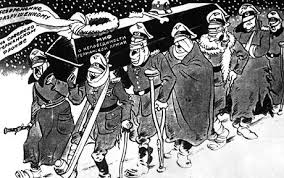Boris Yefimov (Fridlyand), the chief illustrator of Izvestia and a political cartoonist for more than ninety years, died at 109 (variously reported as 107 and 108) on this date in 2008. Yefimov published his first book of political cartoons in 1924, with a foreword by Leon Trotsky; the publisher was executed for permitting this, once Trotsky became persona non grata in Stalin’s USSR. Yefimov’s own brother Mikhail, a journalist, was also killed by Stalin, in 1940. Yet Yefimov, in the course of creating more than 70,000 political cartoons, managed to survive a close, at times even collaborative, relationship with the Soviet dictator, who had a great fondness for cartoons and a keen interest in propaganda, and at time suggested topics and themes to the artist. Yefimov was in attendance at the Nuremberg War Crimes Trials, where he caricatured the Nazi defendants. He received the Stalin Prizes in 1950 and 1951 and was named “People’s Painter of the USSR” in 1967. “Over almost the entire history of the Soviet Union,” wrote the New York Times in its obituary, “Mr. Yefimov’s cartoons provided sharp commentary on subjects as varied as laziness on collective farms, bureaucratic inefficiency . . . foreign policy trouble spots like Berlin and Yugoslavia, the Kennedy assassination and Mikhail S. Gorbachev’s attempt to reform and salvage communism.”
“Propaganda was born together with the Soviet regime in 1917, and through all 70 years of its existence, propaganda helped to consolidate society, held it in some kind of unified, strong community. And when the Soviet Union disappeared and propaganda disappeared with it, there was left a sort of emptiness.” —Boris Yefimov


























